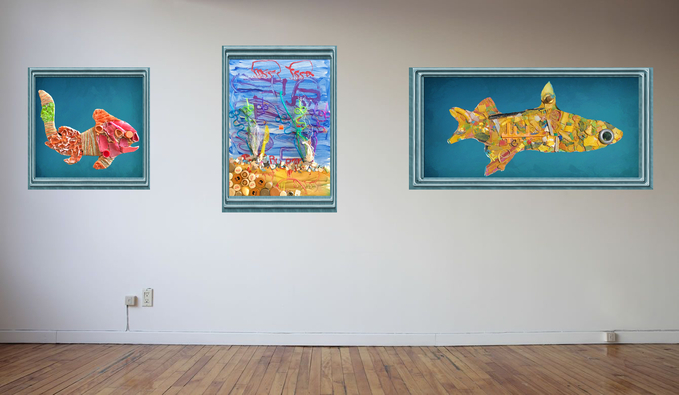Plastics
- Plastic is a very useful material; lightweight, flexible and has many uses. The amount of single-use or short-term use plastics has contributed to the growing and global problem of plastic marine pollution. Global plastics production has increased exponentially since 1950, with 311 million metric tons produced in 2014.
- Half of the world's plastic now in existence was made in just the last 13 years, with most of that for products used only once and then discarded.
- None of the commonly used plastics are biodegradable. As a result, they accumulate, rather than decompose, in landfills or the natural environment. Every piece of plastic that ever ended up in the environment is still around.
Journey to the Ocean
- Much of the plastic in the ocean today comes directly from sources on land, often reaching the ocean as runoff that moves litter from land to river and finally, the ocean. A 2015 study found that there is on average 8 million tonnes of plastic that enters the ocean from land every year, but that the actual amount could vary between 4.8 and 12.7 million tonnes. This plastic can float or sink, and travel in ocean currents, collecting in gyres which make up large garbage patches covering areas three times the size of France.
- Plastic makes up 80% of all marine debris. It is estimated that 80% of this plastic comes from land-based sources, while shipping, fishing and aquaculture make up the other 20%
- Plastic has been detected on the shorelines of all continents even Antarctica and remote locations with no inhabitants, with more plastic materials found near densely populated areas. It is found in Arctic Ice, in the sediments on the sea floor, in open ocean and along coastlines.
- Plastic is extremely durable and doesn't biodegrade with microbes. Instead, it photodegrades from exposure to the sun. This means most commonly used plastics do not "go away" in the ocean but continue to break up into smaller and smaller fragments until they are too small to see. These are called microplastics and can be worse than larger pieces; they are more easily eaten by smaller animals and are more difficult to remove. When smaller animals like crustaceans, shellfish and fish eat these microplastics, they will be passed on to their predators and plastics can accumulate up the food chain.
Effects of Plastic Pollution
- Our dependence on plastics in everyday life causes not only physical and biological damage but contributes to climate change in its creation and incineration in some countries.
- The floating rafts of plastic pollution that traverse our oceans have the ability to transport invasive marine organisms and chemical contaminants between ecosystems
- In the ocean, this plastic has major negative effects on wildlife - ingestion, suffocation and entanglement of hundreds in marine species, causing injury, disease and fatalities
- Stomach acids and digestive tracts of most animals are not able to break down the polymers in plastics and will remain in the gut of animals that ingest them indefinitely, meaning that many of them will starve due to false feelings of being full.
- A 2015 study by Australian and British scientists determined that 90% of sea birds living today have ingested some form of plastic. If the trend continues, 99% of sea birds will have plastic in their guts by 2050.
- Approximately 3 billion people worldwide rely on wild-caught and farmed seafood as their main source of protein. There are increasing studies done on the amount of microplastics in the guts of fish. Some of these and associated chemicals have been found to leach into the livers of some fish, which could mean they are travelling to other parts of the body including flesh, which could have impacts on human health.
- Bottled water, beer, shellfish and sea salt have all also been found to contain microplastics. A 2019 study estimated that people are consuming around 2000 microplastics every week through these sources, which equates to a credit card worth of plastic.
Solutions
- Stop the problem at the source. Reduce the amount of single-use plastics in our lives and use and dispose of materials responsibly.
- Consider our waste impacts in everyday life; when eating out, grocery shopping or buying household items. Ask yourself - can you buy second-hand to reduce the need for newly made products? Is the packaging compostable or recyclable? Is there a reusable alternative?
- Participate in beach clean ups, or clean ups around our waterways, to help stop the litter from entering our oceans.
Resources and Further Reading:
https://ocean.si.edu/conservation/pollution/marine-plastics
https://advances.sciencemag.org/content/3/7/e1700782
https://www.researchgate.net/profile/Wallace_Nichols/publication/268187066_Editorial_Plastic_Pollution_An_Ocean_Emergency/links/54c622550cf256ed5a9c8f3c.pdf
https://www.sciencedirect.com/science/article/abs/pii/S0025326X20302484?via%3Dihub
https://ourworldindata.org/plastic-pollution
https://cxgiae.com/everything-you-need-to-know-about-single-use-plastic-bans-and-plastic-bag-ecycling/
